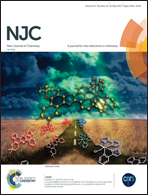Synthesis and catalytic performance of hierarchically structured beta zeolites by a dual-functional templating approach†
Abstract
Hierarchical zeolites are important solid catalysts for the conversion of bulky molecules according to their mesoporosities. In this study, we prepared a hierarchically structured beta zeolite by using a bifunctionalized amphiphilic surfactant, C18-6-diphe, under hydrothermal synthesis conditions. The product was characterized by a combination of X-ray powder diffraction, N2 adsorption–desorption isotherms, scanning electron microscopy, transmission electron microscopy, Fourier transform infrared spectroscopy, 27Al magic-angle spinning nuclear magnetic resonance spectroscopy, thermogravimetric analysis, and NH3 temperature-programmed desorption. The results indicated that the surfactant acted as a dual-functional template for generating both micropores and mesopores simultaneously and that the mesopore walls exhibited zeolite-like micropore frameworks with high hydrothermal stability. The incorporation of Al atoms and the presence of abundant mesopores did not affect the intrinsic acidity of the beta zeolite, especially for weak and medium-strong acids. The hierarchically structured beta zeolite exhibited high catalytic activity due to its mesoporous structure with abundant exposed acid sites on the external surface and short diffusion routes. This hierarchical micro/mesostructured beta zeolite may be a candidate for practical industrial applications especially in those reactions where bulky molecules are involved.



 Please wait while we load your content...
Please wait while we load your content...